'The Root of the Holy Ghost'
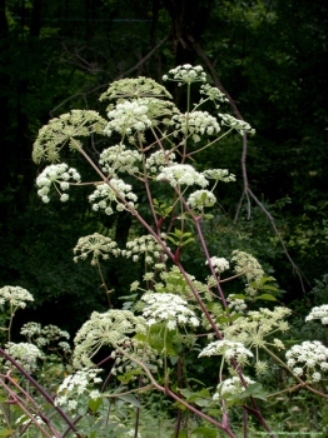 The sacred herb, Angelica, as its name alone implies, has a lofty status in the world of herbal lore. I referred to this herb in my historical fantasy romance novel Daughter of the Wind. I've grown Angelica in the garden, a large aromatic plant with lacy white umbels, but it died out and must be replaced. An ornamental, angelica makes a nice addition to a perennial herb and flower border, but be certain to allow plenty of room; it reaches a height of 4 to 6 feet. The flowers are also appealing to butterflies, another plus. This year, I'd like to put in some plants. I tend to overlook it in all the spring planting madness.
The sacred herb, Angelica, as its name alone implies, has a lofty status in the world of herbal lore. I referred to this herb in my historical fantasy romance novel Daughter of the Wind. I've grown Angelica in the garden, a large aromatic plant with lacy white umbels, but it died out and must be replaced. An ornamental, angelica makes a nice addition to a perennial herb and flower border, but be certain to allow plenty of room; it reaches a height of 4 to 6 feet. The flowers are also appealing to butterflies, another plus. This year, I'd like to put in some plants. I tend to overlook it in all the spring planting madness.
 According to one legend, (European-angelica) Angelica was revealed in a dream by an angel to cure the plague (hence the name Angelica or Archangel). All parts of the plant were believed effective against evil spirits and witchcraft. It was held in such esteem that it was called 'The Root of the Holy Ghost.' In America it was used by the Iroquois and other tribes as Witchcraft Medicine, an infusion of smashed roots were used as wash to remove ghosts from the house." This quote is from an interesting site called Alternative Nature Online Herbal. You can also view lovely pics of Angelic there.
According to one legend, (European-angelica) Angelica was revealed in a dream by an angel to cure the plague (hence the name Angelica or Archangel). All parts of the plant were believed effective against evil spirits and witchcraft. It was held in such esteem that it was called 'The Root of the Holy Ghost.' In America it was used by the Iroquois and other tribes as Witchcraft Medicine, an infusion of smashed roots were used as wash to remove ghosts from the house." This quote is from an interesting site called Alternative Nature Online Herbal. You can also view lovely pics of Angelic there.
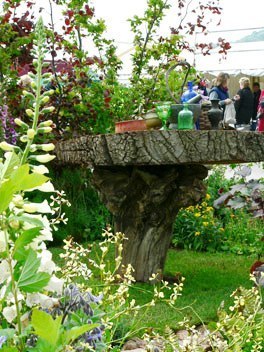 From Real Magick:
From Real Magick:
"As seen by its name, angelica has been associated with the Archangel Michael. It comes into bloom near his feast day and has been connected to the Christian observance of the Annunciation. Angelica is known for its protection against evil spells.
The Master Book of Herbalism considers angelica "one of the most valuable Herbes of Protection." The magical property of angelica works in two ways. One is through establishing protection, creating a barrier against energy which would be destructive or harmful. The other property is through filling the person with an abundance of good, radiant energy. Angelica has a pleasing flavor and may be used internally. It is also an excellent bathing herbe. The attributes of this relative of celery enhance one's aura, aid the person in maintaining a joyful outlook on life, and assist in allowing the internal, psychic self to be open and functional. Angelica may be used in ritual baths, self-blessings and in rituals of purification."~
 From Rodale's Illustrated Encyclopedia of Herbs:
From Rodale's Illustrated Encyclopedia of Herbs:
"Throughout history angelica has been a standout herb…supposed to ward off evil spirits and witches. Peasants would weave necklaces of the leaves for their children to wear to protect them. The juice of the roots was used to make Carmelite water, considered a 'sovereign remedy' and drunk to endure a long life and to protect against the poisons and spells of witches."~
 Here I want to point out that the hysteria over witchcraft peaked in the Middle Ages, but endured well beyond. How many unfortunates were burnt at the stake as a result of witch hunts is uncertain but they numbered in the thousands. Most confessions were gained as the result of torture, although the suggestion has been made that the side effects of some potent herbs made people think they could actually fly and that they possessed special powers. And who's to say that some individuals didn't have special powers. But once condemned, few were powerful enough to keep themselves from a bad end. Note that no witches were ever burned in North America, not even at the Salem Witch Trials. By then, hanging was the preferred method of execution, far more civilized. Burning was so sixteenth century.
Here I want to point out that the hysteria over witchcraft peaked in the Middle Ages, but endured well beyond. How many unfortunates were burnt at the stake as a result of witch hunts is uncertain but they numbered in the thousands. Most confessions were gained as the result of torture, although the suggestion has been made that the side effects of some potent herbs made people think they could actually fly and that they possessed special powers. And who's to say that some individuals didn't have special powers. But once condemned, few were powerful enough to keep themselves from a bad end. Note that no witches were ever burned in North America, not even at the Salem Witch Trials. By then, hanging was the preferred method of execution, far more civilized. Burning was so sixteenth century.
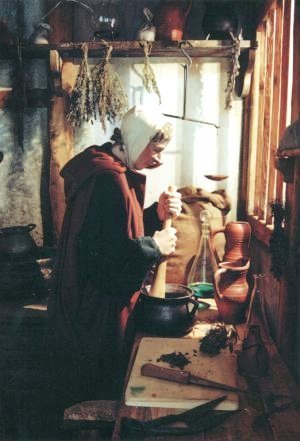 From A Modern Herbal: Garden Angelica. Archangelica officinalis. Parts Used: root, leaves, seeds.
From A Modern Herbal: Garden Angelica. Archangelica officinalis. Parts Used: root, leaves, seeds.
Parkinson, in his Paradise in Sole, 1629, puts Angelica in the forefront of all medicinal plants, and it holds almost as high a place among village herbalists to-day, though it is not the native species of Angelica that is of such value medicinally and commercially. but an allied form, found wild in most places in the northern parts of Europe. This large variety, Angelica Archangelica (Linn.), also known as Archangelica officinalis, is grown abundantly near London in moist fields, for the use of its candied stems. It is largely cultivated for medicinal purposes in Thuringia, and the roots are also imported from Spain.
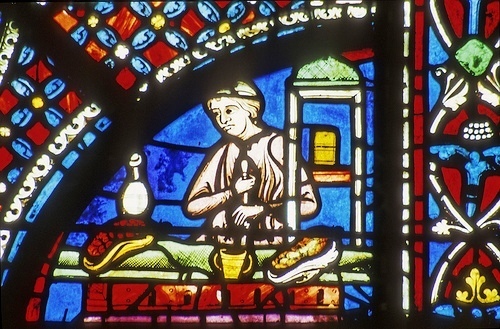 History: Its virtues are praised by old writers, and the name itself, as well as the folk-lore of all North European countries, testify to the great antiquity of a belief in its merits as a protection against contagion, for purifying the blood, and for curing every conceivable malady: it was held a sovereign remedy for poisons agues and all infectious maladies. In Couriand, Livonia and the low lakelands of Pomerania and East Prussia, wild-growing Angelica abounds; there, in early summer-time, it has been the custom among the peasants to march into the towns carrying the Angelica flower-stems and to offer them for sale, chanting some ancient ditty in Lettish, so antiquated as to be unintelligible even to the singers themselves. The chanted words and the tune are learnt in childhood, and may be attributed to a survival of some Pagan festival with which the plant was originally associated."~
History: Its virtues are praised by old writers, and the name itself, as well as the folk-lore of all North European countries, testify to the great antiquity of a belief in its merits as a protection against contagion, for purifying the blood, and for curing every conceivable malady: it was held a sovereign remedy for poisons agues and all infectious maladies. In Couriand, Livonia and the low lakelands of Pomerania and East Prussia, wild-growing Angelica abounds; there, in early summer-time, it has been the custom among the peasants to march into the towns carrying the Angelica flower-stems and to offer them for sale, chanting some ancient ditty in Lettish, so antiquated as to be unintelligible even to the singers themselves. The chanted words and the tune are learnt in childhood, and may be attributed to a survival of some Pagan festival with which the plant was originally associated."~
I'm not at all certain what dialect Lettish is or how useful this info is, but I am intrigued by the image of happy peasants chanting ancient Lettish ditties while frolicking with Angelica. I mean, who knew?
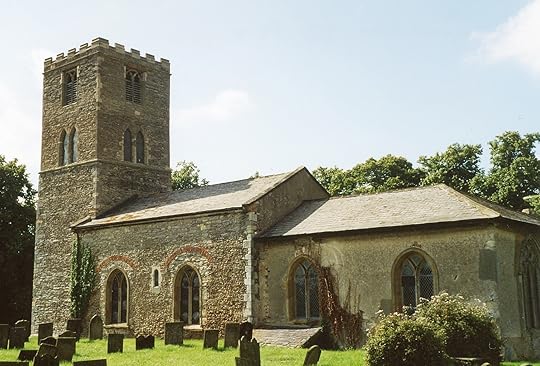 The author goes on to say, "After the introduction of Christianity, the plant became linked in the popular mind with some archangelic patronage, and associated with the spring-time festival of the Annunciation. According to one legend, Angelica was revealed in a dream by an angel to cure the plague. Another explanation of the name of this plant is that it blooms on the day of Michael the Archangel (May 8, old style), and is on that account a preservative against evil spirits and witchcraft: all parts of the plant were believed efficacious against spells and enchantment. It was held in such esteem that it was called 'The Root of the Holy Ghost.'
The author goes on to say, "After the introduction of Christianity, the plant became linked in the popular mind with some archangelic patronage, and associated with the spring-time festival of the Annunciation. According to one legend, Angelica was revealed in a dream by an angel to cure the plague. Another explanation of the name of this plant is that it blooms on the day of Michael the Archangel (May 8, old style), and is on that account a preservative against evil spirits and witchcraft: all parts of the plant were believed efficacious against spells and enchantment. It was held in such esteem that it was called 'The Root of the Holy Ghost.'
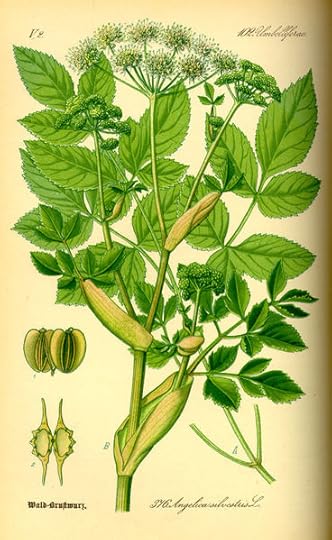 Angelica is unique amongst the Umbelliferae (*which means plants with umbel shaped flowers, think Queen Ann's Lace) for its pervading aromatic odour, a pleasant perfume, entirely differing from Fennel, Parsley, Anise, Caraway or Chervil. One old writer compares it to Musk, others liken it to Juniper. Even the roots are fragrant, and form one of the principal aromatics of European growth- the other parts of the plant have the same flavour, but their active principles are considered more perishable. In several London squares and parks, Angelica has continued to grow, self-sown, for several generations as a garden escape; in some cases it is appreciated as a useful foliage plant, in others, it is treated rather as an intruding weed. Before the building of the London Law Courts and the clearing of much slum property between Holywell Street and Seven Dials, the foreign population of that district fully appreciated its value, and were always anxious to get it from Lincoln's Inn Fields, where it abounded and where it still grows. Until very recent years, it was exceedingly common on the slopes bordering the Tower of London on the north and west sides; there, also, the inhabitants held the plant in high repute, both for its culinary and medicinal use."~
Angelica is unique amongst the Umbelliferae (*which means plants with umbel shaped flowers, think Queen Ann's Lace) for its pervading aromatic odour, a pleasant perfume, entirely differing from Fennel, Parsley, Anise, Caraway or Chervil. One old writer compares it to Musk, others liken it to Juniper. Even the roots are fragrant, and form one of the principal aromatics of European growth- the other parts of the plant have the same flavour, but their active principles are considered more perishable. In several London squares and parks, Angelica has continued to grow, self-sown, for several generations as a garden escape; in some cases it is appreciated as a useful foliage plant, in others, it is treated rather as an intruding weed. Before the building of the London Law Courts and the clearing of much slum property between Holywell Street and Seven Dials, the foreign population of that district fully appreciated its value, and were always anxious to get it from Lincoln's Inn Fields, where it abounded and where it still grows. Until very recent years, it was exceedingly common on the slopes bordering the Tower of London on the north and west sides; there, also, the inhabitants held the plant in high repute, both for its culinary and medicinal use."~
 *Bear in mind that A Modern Herbal was written in the early 20th century and I have no idea if Angelica is still springing up in London parks. If any of you have the inside scoop, do tell. Ms. Grieve is a big fan of this herb and gives meticulous advice about cultivation, etc, but I have abbreviated her copious information.
*Bear in mind that A Modern Herbal was written in the early 20th century and I have no idea if Angelica is still springing up in London parks. If any of you have the inside scoop, do tell. Ms. Grieve is a big fan of this herb and gives meticulous advice about cultivation, etc, but I have abbreviated her copious information.
Cultivation: Cultivate in ordinary deep, moist loam, in a shady position, as the plant thrives best in a damp soil and loves to grow near running water.
Parts Used: The roots and leaves for medicinal purposes, also the seeds.
 Uses: Angelica is largely used in the grocery trade, as well as for medicine, and is a popular flavouring for confectionery and liqueurs. The appreciation of its unique flavour was established in ancient times. The use of the sweetmeat may probably have originated from the belief that the plant possessed the power of averting or expelling pestilence. The flavour of Angelica suggests that of Juniper berries, and it is largely used in combination with Juniper berries, or in partial substitution for them by gin distillers. The stem is largely used in the preparation of preserved fruits and 'confitures' generally, and is also used as an aromatic garnish by confectioners. The seeds especially, which are aromatic and bitterish in taste, are employed also in alcoholic distillates, especially in the preparation of Vermouth and similar preparations, as well as in other liqueurs, notably Chartreuse.
Uses: Angelica is largely used in the grocery trade, as well as for medicine, and is a popular flavouring for confectionery and liqueurs. The appreciation of its unique flavour was established in ancient times. The use of the sweetmeat may probably have originated from the belief that the plant possessed the power of averting or expelling pestilence. The flavour of Angelica suggests that of Juniper berries, and it is largely used in combination with Juniper berries, or in partial substitution for them by gin distillers. The stem is largely used in the preparation of preserved fruits and 'confitures' generally, and is also used as an aromatic garnish by confectioners. The seeds especially, which are aromatic and bitterish in taste, are employed also in alcoholic distillates, especially in the preparation of Vermouth and similar preparations, as well as in other liqueurs, notably Chartreuse.
From ancient times, Angelica has been one of the chief flavouring ingredients of beverages and liqueurs, but it is not a matter of general knowledge that the Muscatel grape-like flavour of some wines, made on both sides of the Rhine, is (or is suspected to be) due to the secret use of Angelica. An Oil of Angelica, which is very expensive, was prepared in Germany some years ago: it is obtained from the seeds by distillation with steam, the vapour being condensed and the oil separated by gravity. Besides being employed as a flavouring for beverages and medicinally, Angelica seeds are also used to a limited extent in perfumery.
 Medicinal Action and Uses: The root stalks, leaves and fruit possess carminative, stimulant, diaphoretic, stomachic, tonic and expectorant properties, which are strongest in the fruit, though the whole plant has the same virtues. Angelica is a good remedy for colds, coughs, pleurisy, wind, colic, rheumatism and diseases of the urinary organs, though it should not be given to patients who have a tendency towards diabetes, as it causes an increase of sugar in the urine. It is generally used as a stimulating expectorant, combined with other expectorants the action of which is facilitated, and to a large extent diffused, through the whole of the pulmonary region. It is a useful agent for feverish conditions, acting as a diaphoretic.
Medicinal Action and Uses: The root stalks, leaves and fruit possess carminative, stimulant, diaphoretic, stomachic, tonic and expectorant properties, which are strongest in the fruit, though the whole plant has the same virtues. Angelica is a good remedy for colds, coughs, pleurisy, wind, colic, rheumatism and diseases of the urinary organs, though it should not be given to patients who have a tendency towards diabetes, as it causes an increase of sugar in the urine. It is generally used as a stimulating expectorant, combined with other expectorants the action of which is facilitated, and to a large extent diffused, through the whole of the pulmonary region. It is a useful agent for feverish conditions, acting as a diaphoretic.
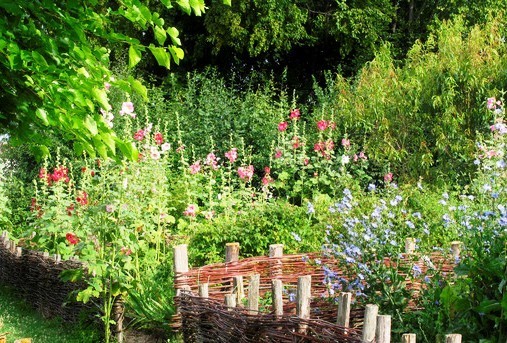 An infusion may be made by pouring a pint of boiling water on an ounce of the bruised root, and two tablespoonsful of this should be given three or four times a day, or the powdered root administered in doses of 10 to 30 grains. The infusion will relieve flatulence, and is also of use as a stimulating bronchial tonic, and as an emmenagogue. It is used much on the Continent for indigestion, general debility and chronic bronchitis. For external use, the fresh leaves of the plant are crushed and applied as poultices in lung and chest diseases.
An infusion may be made by pouring a pint of boiling water on an ounce of the bruised root, and two tablespoonsful of this should be given three or four times a day, or the powdered root administered in doses of 10 to 30 grains. The infusion will relieve flatulence, and is also of use as a stimulating bronchial tonic, and as an emmenagogue. It is used much on the Continent for indigestion, general debility and chronic bronchitis. For external use, the fresh leaves of the plant are crushed and applied as poultices in lung and chest diseases.
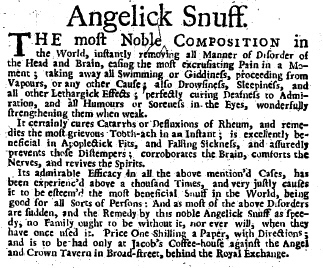 The following is extracted from an old family book of herbal remedies: 'Boil down gently for three hours a handful of Angelica root in a quart of water; then strain it off and add liquid Narbonne honey or best virgin honey sufficient to make it into a balsam or syrup and take two tablespoonsful every night and morning, as well as several times in the day. If there be hoarseness or sore throat, add a few nitre drops.'
The following is extracted from an old family book of herbal remedies: 'Boil down gently for three hours a handful of Angelica root in a quart of water; then strain it off and add liquid Narbonne honey or best virgin honey sufficient to make it into a balsam or syrup and take two tablespoonsful every night and morning, as well as several times in the day. If there be hoarseness or sore throat, add a few nitre drops.'
A somewhat similar drink, much in use on the Continent in the treatment of typhus fever, is thus prepared: 'Pour a quart of boiling water upon 6 oz. of Angelica root cut up in thin slices, 4 oz. of honey, the juice of 2 lemons and 1/2 gill of brandy. Infuse for half an hour.' Formerly a preparation of the roots was much used as a specific for typhoid. (*However, whether it worked is another matter.)
 Angelica stems are also grateful to a feeble stomach, and will relieve flatulence promptly when chewed. An infusion of Angelica leaves is a very healthful, strengthening tonic and aromatic stimulant, the beneficial effect of which is felt after a few days' use. The yellow juice yielded by the stem and root becomes, when dry, a valuable medicine in chronic rheumatism and gout. Taken in medicinal form, Angelica is said to cause disgust for spirituous liquors. (*It occurs to me that this might be beneficial to alcoholics). It is a good vehicle for nauseous medicines and forms one of the ingredients in compound spirit of Aniseed. Gerard, among its many virtues that he extols, says 'it cureth the bitings of mad dogs and all other venomous beasts.'~
Angelica stems are also grateful to a feeble stomach, and will relieve flatulence promptly when chewed. An infusion of Angelica leaves is a very healthful, strengthening tonic and aromatic stimulant, the beneficial effect of which is felt after a few days' use. The yellow juice yielded by the stem and root becomes, when dry, a valuable medicine in chronic rheumatism and gout. Taken in medicinal form, Angelica is said to cause disgust for spirituous liquors. (*It occurs to me that this might be beneficial to alcoholics). It is a good vehicle for nauseous medicines and forms one of the ingredients in compound spirit of Aniseed. Gerard, among its many virtues that he extols, says 'it cureth the bitings of mad dogs and all other venomous beasts.'~
*And I ask, what more could you want of any plant? As always, questions or comments are welcome.
Filed under: Uncategorized Tagged: Angélica, Herb, Herbalism, Maud Grieve, medieval garden, medieval herb garden, medieval herbs, Middle Ages, physic garden, Plant, Rodale's Illustrated Encyclopedia of Herbs, Salem Witch Trials, Securities Exchange Act of 1934, Traditional Chinese medicine











